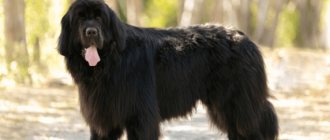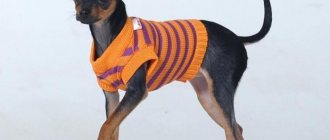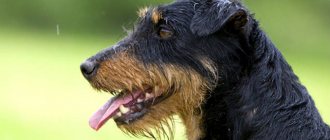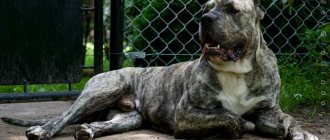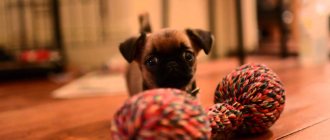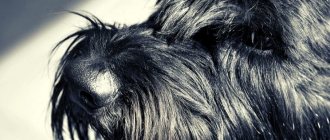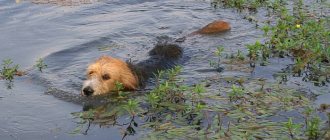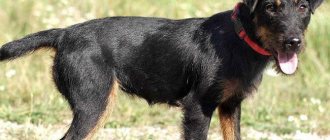Origin story
The Porseline is considered one of the oldest French hunting breeds. It was bred in the 15th century to hunt hare and other small game in the abbeys of Luxelles and Cluny. The founders were the white dogs of St. Hubert (the ancestors of the Bloodhound). They were infused with the blood of other outstanding hunting dogs.
In France, the breed is known as the Dog of Franche-Comte (French: Chien de Franche-Comte`), named after its region of origin, which is located on the border of France and Switzerland.
During the French Revolution, the porcelain hound was almost lost, but was restored by the end of the 19th century through the efforts of Swiss and French hunter-breeders. French, Swiss and English hounds were used in breeding work. The first Porselin breed club was founded in France in 1971. In 1975, the Porcelain Hound was recognized by the FCI.
Purpose
Porselin is used for hunting small game, deer, roe deer and wild boar. Can work alone and in a pack. Divorced with performance tests. He has a very good sense of smell, is persistent, passionate and impulsive in his search. He drives with a voice, the barking is loud and boisterous. Strong and resilient, capable of running long distances and working on steep, rough terrain.
Today, porcelain dogs can be found in other areas. They are used for service in the police and customs, rescue and search operations. They can show themselves in various sports, at exhibitions, and are good family dogs and companions for active people.
Character of the breed
The character of the porselen includes the traits of a true hunter and a devoted friend. These are both affectionate and independent, kind and impulsive, smart and passionate, loyal and stubborn dogs that can become a true friend and reliable companion for their owner.
Porcelains take root well in families, maintaining affection and loyalty not only to the owner, but also to other family members. Porcelain hounds adore children, treat them with special tenderness and are ready to forgive them a lot.
But Porcelain puppies have a very cocky character, so dogs of this breed need to be raised from childhood, showing who is boss. Training Porcelains is not always easy, since these dogs are very independent and are not ready to carry out all commands the first time - and not because they cannot, but because they do not want to at the moment.
If you need a guard dog, it is better to take a closer look at other breeds: Porcelains are very friendly towards strangers and can even allow themselves to be petted.
Appearance
Perselen is an elegant, proportionally built medium-sized dog with a beautifully chiselled head, long ears and slender, strong legs. The main distinguishing feature is the short white-red fur, through which dark spots on the skin are visible. Sexual dimorphism is moderately expressed.
- Height at withers: 54-58 cm
- Weight: 25-28 kg cm
The head is dry, chiseled. The skull is wide between the ears, rounded. Stop moderate. The muzzle is long, the bridge of the nose is straight or with a slight hump. The lobe is developed, black. The upper lip slightly covers the lower one, without sagging. Mucous black. The eyes are dark and medium in size. The ears are long, thin, curled inward, set below the eye line. The neck is long, a slight dewlap is allowed.
The body is proportionally folded, square format. The back is wide and straight. The loin is convex. The maklaks are slightly noticeable. The chest is moderately wide and deep. The belly is tucked in. The tail is thick at the base, tapers noticeably towards the tip, and is of medium length. The limbs are strong, rather long, dry.
The skin is elastic, thin, and is called “marbled” because of the numerous black spots on a white background. The coat is thin, smooth and shiny, and lies tightly. The color is white with orange spots that do not blend into the coat.
Breed standard
The Porselen has a stretched body with a straight, wide back and a muscular loin. The dog's sides and belly are tucked up. The croup is slightly sloping. The neck is long, of medium thickness. The chest is not wide, but deep and low.
The head is elongated, with a wide skull and a rounded nape. The dog's forehead is flat and the middle furrow is clearly visible on it. The transition from the muzzle to the forehead is smooth. Porselen's eyes are large, brown, almost black.
The ears are thin, long, with pointed ends, set at eye level or slightly lower.
The limbs are fine-boned, long, strong. The toes are thin, tightly compressed with hard pads.
The tail of the porselen is thick at the base and thins towards the end.
The coat is thin and short.
Character and behavior
The Porselen is primarily a hunting dog with a strong desire to follow its nose and a malice towards small game. Gentle and affectionate with all family members, including children. Friendly to guests. It is not afraid of strangers and has watchdog qualities, but is not aggressive. At home he behaves quietly, quite calm and neat. Barks a little.
Porcelain hounds are obedient and loyal to their owner. They have a hard time experiencing lack of attention and unfair treatment.
The breed was bred to work in a pack, so gets along well with other dogs if raised appropriately, but prefers to be the owner's sole object of affection. Training abilities are average. It is important to pay attention to the socialization of the dog from an early age and train it, taking into account the specific temperament of the hounds.
Character
If we talk about the Porcelain as a pet, then it is a smart, kind, affectionate, calm dog. As a hunter, she displays such qualities as perseverance, passion, and impulsiveness. She is merciless towards the hunted beast.
Porselen is very attached to his owner and agrees to obey only him. In general, the breed is independent and independent. Without these qualities she would not be such a great hunter. Porselen gets along well with other pets. Loves children.
at
Content Features
Porselen is better suited for home keeping. It is poorly adapted for year-round life on the street, but can live in a separate warm room with access to a spacious enclosure. Not the best option for an apartment if the owner cannot provide a sufficient level of physical activity.
The Porcelain Hound needs the opportunity to get rid of excess energy, develop hunting talents and maintain good physical condition. Daily walking should last at least 2-3 hours. Free walks in nature are required. Perselen can be a running or cycling companion.
Care comes down to simple hygiene procedures: regular brushing for short-haired breeds, washing, periodic cleaning of ears, teeth and trimming of nails as necessary.
Maintenance and care
The Porcelain Hound does not require special care. However, she needs physical activity to maintain working shape.
- The wool is cleaned regularly using a special soft brush.
- Like any white dog, it needs to be washed when it gets dirty, especially after a hunt.
- Inspect ears for mites.
- The Porcelain Hound is a very calm dog, but it is fast and reckless, very vicious. Her character has firmness and confidence, as well as independence.
- Requires training.
- She becomes very attached to her owner, especially to his children, with whom she is ready to play and run all day long.
- Life expectancy is 13-15 years.
Dog diet
For this dog, only natural products are inherent due to its hunting breed. Every day she should eat at least 0.5 kg of boiled meat (beef, lamb or chicken). She also needs offal such as tripe, chicken heads or necks.
The daily menu should include boiled vegetables (at least 200 grams), which can be added to soups and porridges. Dairy products can only be given to a dog if it has not eaten meat that day.
Dog care
This smooth-haired dog is quite easy to care for, as its coat repels all dust and dirt. Meanwhile, it needs to be brushed regularly to remove excess hair that has fallen out. After a walk, you need to inspect your pet for ticks and other insects that could harm him. Thorns should be carefully selected from the bottom of the paws. It is also necessary to check the dog's ears, as he is prone to diseases such as otitis media.
Keeping a dog
Since the Frafor hound is a fairly large breed, there is no point in keeping it in a small apartment, since it will not have enough space. It is best to buy such a friend for a country house with a large plot of land, where she can freely walk and frolic in nature.
Porcelain hound: photo, description of the breed, history, care
Where to buy a puppy
Porselen is a rather rare breed. Most of the total livestock is concentrated in France, Italy and Switzerland. There are nurseries in Germany, the Czech Republic, Serbia, Denmark, Great Britain, some other European countries and the USA. It is better to look for a breeder abroad, information about planned matings or the availability of puppies through breed clubs.
Porcelains were brought to Russia relatively recently, but have already become a favorite among many dog lovers. Every year the livestock is replenished with dogs, which are a good show type and, at the same time, are not devoid of hunting talents.
Price
The average cost of a porcelain hound puppy in Europe is 700 euros.
Character traits
Porcelains are distinguished by their calmness, devotion and affectionate behavior towards their owners. They are very attached to their owner and cannot stand loneliness, so you need to regularly show them your attention, communicate with them and try not to leave them alone. While participating in the hunt, they show active passion and ruthlessness towards game, but in a calm environment at home, they change and become quiet family dogs. They maintain good relations with their fellow Porcelains, never start fights or get involved in conflicts. They have a self-sufficient and independent character, so it will be difficult for a novice dog breeder to cope with them, and the best owner for them will be an experienced dog breeder who is able to maintain his authority and raise the dog in such a way that it brings results. These dogs require long and persistent training, so special attention should be paid to raising the puppy.
Porcelains are unpretentious in terms of living conditions; they feel good both living in a house outside the city and in a city apartment. However, being hunters from birth, they need constant physical activity and walks, where they can frolic and run as much as they want to burn off excess energy. If they have this opportunity, they will always feel great and stay healthy. Therefore, it is preferable to keep them where there are large spaces for walking, with owners who themselves prefer an active lifestyle.
Uniqueness of the breed
The Porselen appeared on the Swiss-French border and is the successor of the extinct Motebeuf hound breed. Among the ancestors of the modern Porcelain Dog are the English Foxhounds, Somerset Harriers, and Laufhunds.
The Porcelain Dog owes its name to its appearance. Its shiny, bright white coat and sleek silhouette are reminiscent of porcelain figurines.
Basically, the Porselin dog breed has taken root among the French, but sometimes representatives can be found in Italy and Switzerland.
Almost extinct after the revolution in France, the Porcelain Porselen was taken over by Swiss breeders for active restoration after 1845. Until this time, it was called the Burgundy Dog after the name of the place where it appeared. Only over time, thanks to its exquisite appearance, the pet was given the name “Porcelain Hound”.
The French club of Porselin breed lovers, formed in 1971, contributed to a surge in the number of Porcelain dogs, but this did not become the impetus for their spread to other countries. The porcelain breed settled in French, Italian and Swiss territories.
Feeding regimen and diet
Despite the popularity of ready-made diets, it is recommended to feed porcelain hounds natural food. The main ingredient of the diet should be meat; an adult dog eats 400-500 grams of lean beef, chicken, lamb or turkey per day. You can also give the dog offal - tripe, necks and heads of chickens. There are vegetables on the menu, but not more than 200-250 grams per day.
Porridge is cooked for the pet - with meat, added herbs, vegetable oil. It is not recommended to give your hound fermented milk products on the same day as meat; this is not the best combination of food for Porcelains.
If the owner does not have time to prepare food for the dog, it is permissible to feed it with ready-made industrial food, but it must be a high-quality product that does not contain components that can cause allergies.
Description of the breed
Dog handlers say: this breed is not suitable for an inexperienced dog breeder - you need to know its characteristics well, show patience and sometimes firmness in matters of care and education.
Breed standard
Here's how experts characterize the breed:
- the head is elongated, as if sculpted by a sculptor (how could it be otherwise for a porcelain dog?);
- large brown eyes are reliably protected by eyelids, the look is intelligent;
- ears - large, soft, curled inward, located on the line of the eyes, and sometimes slightly lower;
- the nose and mucous membranes of the lips are black;
- neck – long;
- body – stretched, back – wide;
- chest - quite wide, well developed, low dropped;
- the tail , strong at the base, gradually turns into a thin, slightly curled tail;
- the limbs are straight and long, but could have been more graceful for such an exquisite breed;
- The pads on the paws are hard.
The coat of a porcelain dog is its undoubted pride: smooth, with a vibrant shine, without any bald spots. The color is also worthy of admiration; experts characterize it as “bright white.” It is interestingly complemented by orange spots, mainly on the ears. Typically, staining occurs where the skin contains black pigment.
Interestingly, a white fur coat will not require frequent water treatments for your pet. The structure of the wool is designed in such a way that it repels dirt well. But in order for the pet to always look perfect, the owner needs to arm himself with a brush several times a week that will comb out dead hairs from the fur coat. This procedure will only take a few minutes.
The size of the animal is acceptable for home keeping. Males are larger than young ladies, their height is from 55 to 58 centimeters (their girlfriends are from 53 to 56 ). Animals weigh on average from 25 to 28 kilograms.
The lifespan of these exquisite animals is between 13 and 15 years .
Hunting behavior
This breed was purposefully created as a hunting breed, so the animals perfectly track prey and have an exceptional sense of smell. In order for the porcelain hound to work in a pack, it was taught not to be aggressive towards its “colleagues”. However, she can hunt not only in a team, but also alone.
Representatives of this breed are targeted at hares, roe deer, deer, and are sometimes used in wild boar hunting. The animal is hardy , so it does its job well - with a loud bark it informs its owner that its search has been a success. Neither bad weather nor difficult terrain will hinder the porselen.
Hunters note: the porcelain hound as a pursuer is merciless towards its prey , but at home it is all kindness and serenity. However, if there are other pets in the family, the picture may not be so idyllic. It is very difficult for Porselen to calm down his hunting instincts, so the cat next to him will not be happy. For this reason, owners of porcelain beauties almost never have other animals. This applies, for example, to rabbits and ferrets.
If the dog is “idle” as a hunting dog, it requires serious physical activity in the form of long walks, active games in the air, and playing some kind of sport together with a person.
For such a lifestyle, the dog must be in exceptional health, and he really does not require frequent visits to the veterinarian. Among the most common diseases are ear infections and associated hearing loss , as well as luxating kneecaps.

